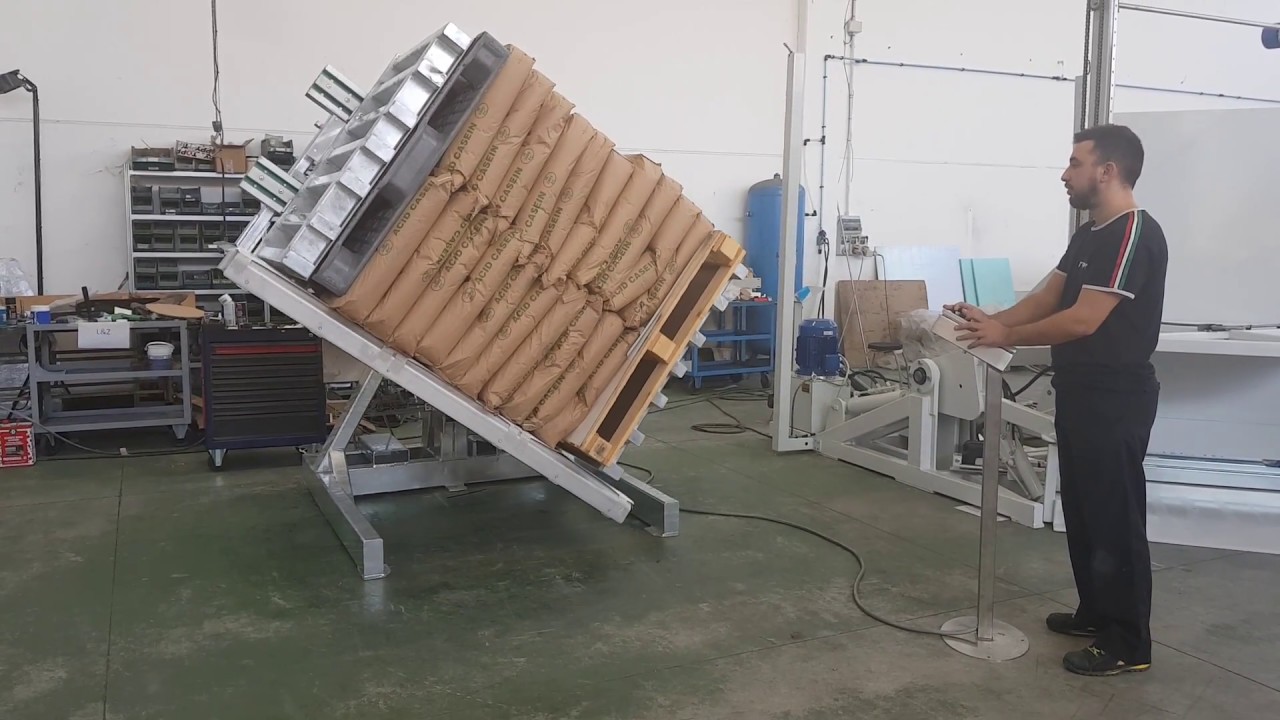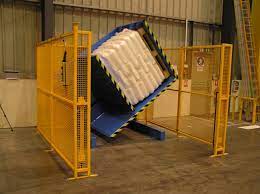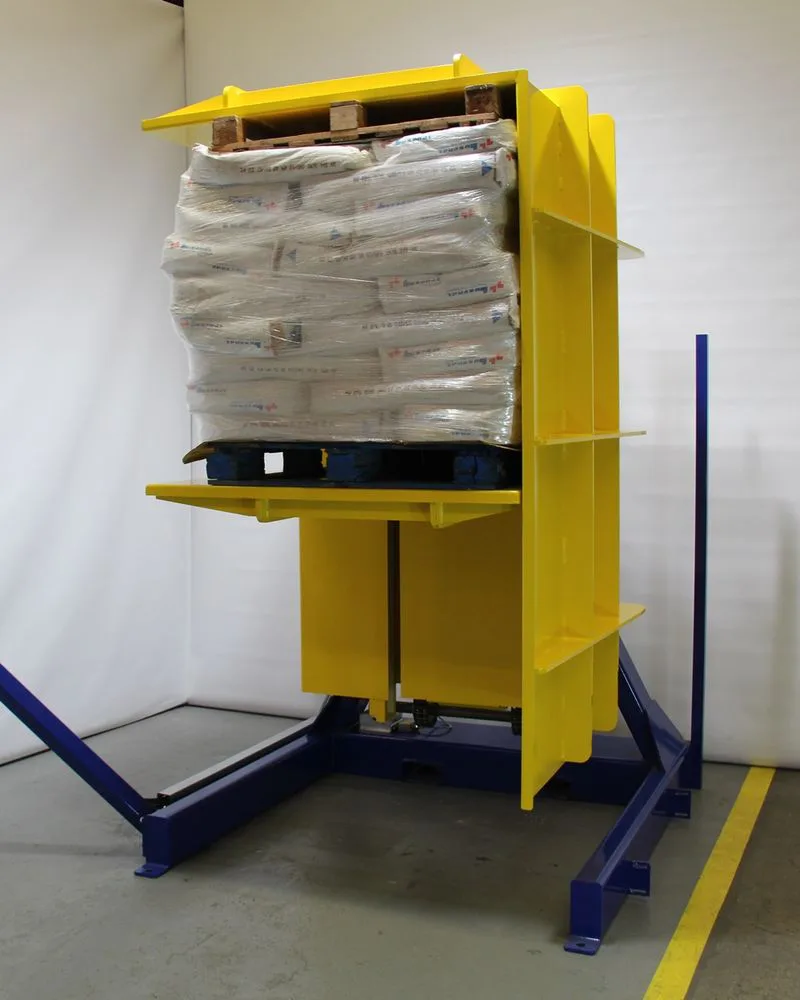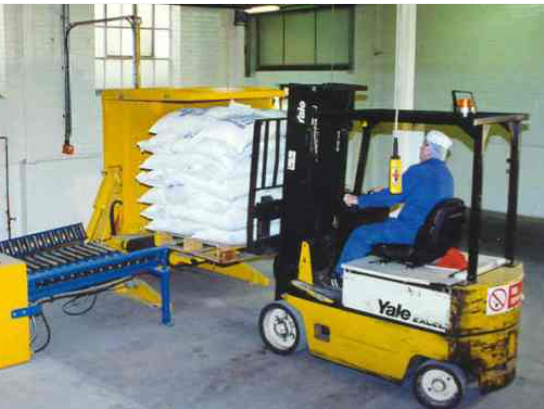From Manual to Smart: Pallet Inverters Transforming Vietnam's Material Handling
Are you struggling with the slow, dangerous, and costly process of manually handling palletized goods? Many warehouses and factories in fast-growing economies like Vietnam face this exact problem. The reliance on manual labor leads to damaged products, workplace injuries, and operational bottlenecks that just can’t keep up with modern demand. This inefficiency directly eats into your profit margins and limits your ability to scale.
A pallet inverter is a machine that automates the process of turning a palletized load 180 degrees. This allows for the quick, safe, and efficient replacement of broken pallets, transfer of goods to different pallet types (like plastic or in-house pallets), or simple load inversion for processing. This single piece of equipment bridges the gap from manual labor to smart material handling, boosting safety, reducing product damage, and significantly speeding up logistics workflows in industries across Vietnam.

I’ve seen this transformation firsthand. For years, companies accepted product damage and slow handling as a "cost of doing business." But it doesn't have to be that way. The move toward smarter automation isn't just about big, complex robotic systems. Sometimes, the most impactful change comes from solving a fundamental, everyday problem. Let’s explore how this straightforward technology is making a huge difference in Vietnam's bustling industrial landscape.
How do pallet inverters bridge the gap between manual labor and automated efficiency?
Does your team still flip heavy loads or swap pallets by hand? It’s a process fraught with risk. You risk injuring your workers, damaging your products, and creating a major bottleneck in your supply chain. Every minute spent on this manual task is a minute you're not shipping product, and every damaged item is a direct loss. It feels like an old, inefficient problem that has no simple solution.
Pallet inverters provide a direct, mechanical solution that immediately closes the gap between dangerous manual work and efficient automation. They secure a full pallet load, rotate it safely, and allow for the pallet to be swapped out in a matter of seconds. This single action eliminates the need for manual unstacking and restacking, drastically cutting down on labor time, risk of injury, and potential for product damage. It’s a targeted piece of automation that solves a very specific, but very common, operational pain point.

Let’s dive deeper into this transition. It’s not just about replacing a manual task. It’s about introducing a new level of control and predictability into your operations. When I first started in this industry, I saw factories where three or four workers would spend 20 minutes manually restacking a pallet of goods. The process was slow, but worse, it was inconsistent. The risk of a dropped box or a strained back was always present.
The True Cost of Manual Handling
Manual pallet handling isn't free, even if you think you're saving on equipment costs. The hidden costs are significant. You have direct labor costs for the workers involved. But you also have indirect costs. These include higher insurance premiums due to workplace injury risks, the cost of damaged goods that must be discarded, and the operational cost of production lines waiting for materials. It’s a constant drain on resources. Think about the physical strain on your employees. Repetitive lifting of heavy objects is a leading cause of musculoskeletal disorders, leading to worker compensation claims and lost productivity.
The Core Function of a Pallet Inverter
A pallet inverter is fundamentally a simple machine. It has a powerful clamping mechanism that holds the entire load securely. Then, a robust hydraulic or electric system rotates the load. The operator can then easily remove the old pallet from the top and place a new one. The machine rotates the load back, and it's ready to go. The entire process takes about 60 seconds with one operator. This is a massive leap in efficiency. But the real "smart" part is the consistency. Every turn is the same. Every load is secure. You remove the human element of error and fatigue from a high-risk task.
From Simple Inversion to Smart Integration
Modern pallet inverters are more than just rotators. They can be integrated into fully automated conveyor lines. They can handle a wide range of load sizes and weights, with adjustable clamping pressure to protect delicate goods. Some models offer PLC controls that can be connected to a central Warehouse Management System (WMS). This allows you to track pallet swaps and manage inventory with greater accuracy. This is how a simple mechanical solution becomes a key part of a larger, smarter logistics system.
| Metric | Manual Pallet Swapping | Pallet Inverter Usage |
|---|---|---|
| Time per Pallet | 15-25 minutes | 1-2 minutes |
| Labor Required | 2-4 Workers | 1 Operator |
| Risk of Injury | High (strains, sprains) | Very Low |
| Risk of Product Damage | Moderate to High | Very Low |
| Process Consistency | Low | High |
| Integration Potential | None | High (Conveyors, WMS) |
This table clearly shows the jump in performance. It’s not an incremental improvement. It is a fundamental shift in how a core logistics task is performed.
What specific ROI can Vietnamese businesses expect from investing in a pallet inverter?
You're running a business in Vietnam, and every Dong counts. You look at a new piece of equipment like a pallet inverter and ask a simple question: "Is it worth the money?" You're worried about the upfront investment. You wonder if the promised savings in labor and reduced damage will actually show up on your bottom line. It's a valid concern, especially when capital could be used for other pressing needs.
The Return on Investment (ROI) for a pallet inverter is typically realized within 12 to 24 months, making it one of the most financially sound investments in material handling. The ROI is calculated from direct labor savings, a dramatic reduction in product damage costs (often by over 90%), and increased throughput. For a Vietnamese business handling even 20 pallets per day, the savings from re-deploying labor and preventing write-offs can quickly surpass the initial cost of the machine.

Let's break down the numbers in a way that makes sense for a business owner or a plant manager. The decision to invest is never just about technology. It's about financial performance. I've worked with many clients who were initially hesitant. They saw the price tag but not the value. So, we sat down and did the math together. The results are almost always surprising.
Calculating Direct Cost Savings
This is the easiest part of the ROI calculation. Let's imagine a scenario common in many Vietnamese manufacturing plants.
- Manual Method: It takes two workers 20 minutes to transfer a load. Let's say the average labor cost, including benefits, is 120,000 VND per hour per worker.
- Cost per pallet = 2 workers (20/60 hours) 120,000 VND/hr = 80,000 VND.
- Pallet Inverter Method: It takes one operator 2 minutes.
- Cost per pallet = 1 worker (2/60 hours) 120,000 VND/hr = 4,000 VND.
- Savings per pallet = 76,000 VND.
If your facility handles 30 pallets a day, that's a daily saving of 2,280,000 VND. Over a year of 250 working days, that's 570,000,000 VND in direct labor savings alone. This number often gets the attention of any CFO.
Factoring in Indirect Benefits
The financial impact doesn't stop with labor. These indirect benefits are just as important.
- Reduced Product Damage: Manual handling leads to drops, crushes, and spills. If you have a 1% damage rate on loads valued at 20,000,000 VND, you're losing 200,000 VND per incident. A pallet inverter can virtually eliminate this type of damage. If it prevents just one such incident a week, that's another 10,400,000 VND saved per year. For many industries, especially food, beverage, and pharmaceuticals, this is a huge factor.
- Improved Worker Safety: The cost of one serious workplace injury can be devastating. It includes medical bills, compensation claims, lost time, and potential government fines. A pallet inverter removes one of the most common causes of back injuries in the warehouse. This lowers your insurance risk and contributes to a safer, more positive work environment.
- Increased Throughput: A faster process means your entire line moves faster. Trucks are loaded and unloaded quicker. Raw materials get to the production line sooner. This increase in operational velocity allows you to handle more volume without adding more staff or space.
A Sample ROI Projection
Let's put it all together in a simplified table for a mid-sized Vietnamese factory.
| Item | Cost / Savings (VND) | Notes |
|---|---|---|
| Initial Investment (Pallet Inverter) | -450,000,000 | One-time cost, includes installation |
| Annual Labor Savings | +570,000,000 | Based on 30 pallets/day |
| Annual Product Damage Reduction | +50,000,000 | Conservative estimate |
| Annual Safety/Insurance Savings | +20,000,000 | Estimated reduction in premiums/claims |
| Total Annual Savings | +640,000,000 | |
| Payback Period | ~8.4 Months | (Initial Investment / Total Annual Savings) * 12 |
When you present the numbers this way, the investment decision becomes much clearer. It shifts from being an expense to a strategic move that pays for itself in less than a year and continues to generate savings for years to come.
Why is Vietnam a prime example of this material handling revolution?
Looking at Vietnam from the outside, you see incredible growth. But inside the country's factories and warehouses, this rapid expansion creates immense pressure. Companies are trying to meet global demand using logistics infrastructure that is often outdated. They face a shortage of skilled labor, rising operational costs, and increasing demands from international clients for quality and speed. This creates a perfect storm where old, manual methods are simply no longer viable.
Vietnam is a prime example of this revolution because its economic boom is forcing companies to rapidly modernize their internal logistics to survive and compete. The country's strong focus on exports, particularly in manufacturing, electronics, and agriculture, means that goods must be handled efficiently and safely to meet international standards. Pallet inverters and other smart handling solutions are not just "nice to have"; they are essential tools for Vietnamese businesses to scale up, reduce costs, and secure their place in the global supply chain.

I've visited many factories in industrial zones near Ho Chi Minh City and Hanoi. The story is often the same. Five years ago, they had plenty of space and labor was cheap. Today, land is expensive, wages are rising, and their order books are full. The old ways of doing things are holding them back. They are actively looking for solutions.
The Economic Context: A Nation on the Move
Vietnam's GDP growth has been one of the highest in the world for years. This is driven by foreign direct investment (FDI) and a massive shift towards manufacturing. Global giants have set up production here. This creates a ripple effect. Local suppliers need to match the efficiency and quality standards of these multinational corporations. If your goods arrive at their factory on a broken pallet, your contract is at risk. This top-down pressure is a powerful catalyst for adopting better technology.
Key Industries Driving the Change
Certain sectors in Vietnam are leading this transformation because their needs are most acute.
- Food and Beverage: This industry requires high standards of hygiene. Transferring goods from wooden shipping pallets to sanitized in-house plastic pallets is a daily requirement. Doing this manually is slow and risks contamination. A pallet inverter, especially a stainless steel "hygienic" model, solves this problem perfectly.
- Electronics Manufacturing: Delicate and high-value components must be handled with care. A single dropped pallet can represent a huge financial loss. The precision and security of a pallet inverter are critical for protecting these assets.
- Pharmaceuticals: Similar to the food industry, hygiene and product integrity are non-negotiable. Strict regulations often mandate pallet-swapping procedures. Automation is the only way to ensure compliance and efficiency.
- Export Agriculture (e.g., Rice, Coffee): Large volumes of bagged goods need to be moved quickly for export. Slip-sheeting or transferring to shipping pallets are common tasks that are dramatically accelerated with an inverter.
Government Support and Industry 4.0
The Vietnamese government understands the need to modernize. They have initiatives promoting "Industry 4.0" adoption. While this often brings to mind complex robotics and AI, it also includes foundational automation technologies like pallet inverters. There can be incentives or support for companies that invest in technology to improve productivity and export competitiveness. This creates a favorable environment for businesses to upgrade their equipment. This is not just a company-level decision; it is part of a national strategy to move up the value chain. It’s a fascinating process to watch, and a market where the right, simple solution can have an enormous impact.
My Insights: A Lesson from a Dusty Warehouse in Binh Duong
I want to share a story that really shaped my view on this. A few years ago, I visited a mid-sized food processing company in Binh Duong province, near Ho Chi Minh City. The owner, Mr. Tran, was a hardworking man in his late 50s. He had built his business from scratch. His factory was busy, but I could see the chaos in his warehouse.
He had a recurring problem. His products were shipped to Australia, which has very strict regulations. They required all incoming goods to be on specific, pest-treated plastic pallets. His factory, however, used standard wooden pallets for internal movement. Every day, a team of four workers would spend hours manually unstacking bags of product from a wooden pallet and restacking them onto a plastic one.
The process was slow. It was a major bottleneck. Worse, bags would occasionally tear, spilling product on the floor. His workers were complaining of back pain. Mr. Tran saw all of this as the "cost of doing business." He was a traditional owner, and the idea of spending a large sum on a single machine seemed wasteful to him. He told me, "Vincent, my people are cheap. A machine is expensive."
I understood his perspective. I had started on the factory floor myself. I know the value of hard work. But I also know the value of smart work. I didn't try to sell him a machine. Instead, I asked him to help me with some numbers.
- How much product do you lose per month from damaged bags?
- How much does it cost you when a shipment is delayed because the pallet transfer took too long?
- What is the real cost of one worker being out for a week with a back injury?
We sat in his small, dusty office and calculated the figures. He was shocked. The "cheap" labor was costing him a fortune in hidden losses. The bottleneck was costing him potential new orders.
We installed a simple FZ-type pallet inverter. It’s a basic, robust machine. I came back a month later. The change was incredible. The corner of the warehouse that was once a chaotic mess of manual restacking was now clean and efficient. One operator was handling the entire pallet transfer process. Mr. Tran told me he had moved the other three workers to a new packaging line, increasing his overall output. His product damage had dropped to nearly zero. He was no longer worried about shipment deadlines.
He looked at me and said, "Vincent, this machine doesn't just turn pallets. It changed how I see my own business."
That's the core of what we do at SHJLPACK. It's not about selling steel. It's about sharing knowledge that helps people like Mr. Tran transform their operations. It’s about providing a total solution that solves a real, painful problem and helps their business grow.

Conclusion
Ultimately, pallet inverters are a key tool for modernizing material handling. They offer a direct path to higher efficiency, better safety, and significant cost savings for businesses in Vietnam and beyond.




